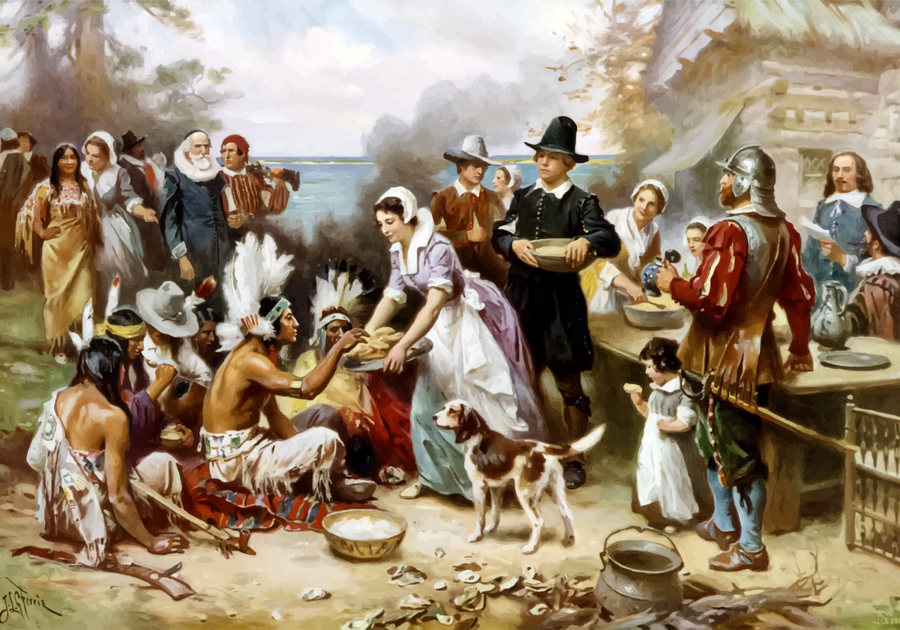Thanksgiving has become a great American holiday held on the 4th Thursday in November. Modernly, it is a day that Americans gather with friends and family for a big feast, watch football and the Thanksgiving Day parade. We share many things in our lives that we are thankful for.
Many students learn about Thanksgiving in school, with the coming together of the Pilgrims and Native Americans in celebration of a harvest. But were things really that simple or have the details faded into the background over time?
Here are 5 things you may not have known about the history of The First American Thanksgiving.
1. Turkey was most likely not served at the First American Thanksgiving
Pilgrim Edward Winslow, wrote about the first Thanksgiving and is one of the only primary sources that we have of this event. He wrote that they sent out 4 men who hunted fowl and brought back enough for a whole week. He also mentioned that wild turkeys were abundant but do not specify that they were at the feast. It is also mentioned that the Native American Wampanoag tribe brought 5 deer to add to the feast. Those are the only foods explicitly mentioned by Winslow.
Sadly, no pie was probably served at the first Thanksgiving either, as the Pilgrims did not have much sugar, or other components needed to make a pie. Sweet potatoes were also not at the feast, as there were no sweet potatoes in America at that time.
2. The Pilgrims didn’t actually invite the Native Americans to the feast
While yes the Native Americans did end up attending the feast, it is not quite certain how that actually happened. The English written history does not actually point to an invitation, while the Native American oral history does not go back as far as this event. Winslow wrote that there were 90 Native American men, including their leader Massasoit, who were entertained and feasted among the Pilgrims for 3 days. It has been speculated, however, that the Pilgrims were firing off their guns in celebration of their harvest, which gained the attention of the nearby Wampanoag’s who came to investigate. This could be how these two cultures came together for this famous feast.
Regardless, this was a remarkable cross-cultural event. This was a remarkable moment in time because over the course of history, Native Americans and the colonists, and later the United States, has had a devastating and violent relationship.
3. Squanto learned English because he was enslaved in Europe and returned to Massachusetts, and still helped the Pilgrims
Squanto was an incredible help to the settlers. He lived on land that the Pilgrims settled on, part of the Patuxet, a group of the Wampanoag tribe. It is believed that he crossed the Atlantic Ocean as many as 6 times, 2 of them as an enslaved person, starting in 1614. It was through these travels and situations that he learned English. He finally arrived back in Massachusetts in 1619 only to find that his tribe had perished. Two years later, he helped the Pilgrims as a translater between them and the Wampanoag tribe, as well as to grow crops. The Pilgrims were ill-equipped for their new home in America. The soil was very acidic, making farming extremely difficult and challenging for them. Squanto taught them to bury a fish with the seeds that he gave them, equalizing the acidity and making their harvest plentiful. He helped them for the first two years the Pilgrims were there. He became an important figure, tieing these two peoples together. He had died a year later from a fever while acting as a guide for Governor Bradford.
4. Only 4 women made the entire 3 day Thanksgiving feast
The Pilgrim husband believed that women had a “weaker body” and that the voyage across the ocean would be too much to bear. Many Pilgrims left their wives and families behind in hopes that they would join them later once things were more settled. However, 18 husbands decided to bring their wives along with them. All 18 women survived the voyage. However, the Pilgrims were ill-equipped for the new land they arrived in. Of the original 18 women that arrived on the Mayflower in November 1620, only 5 women survived to the spring of 1621. By the time of the famous harvest feast, there were only 4 women remaining.
5. Thanksgiving did not become a national Holiday until 1863
In 1863, Abraham Lincoln proclaimed Thanksgiving as a national holiday to celebrate as a way to show gratitude for a win in a Gettysburg battle during the American Civil War. This was a culmination of a 36 year campaign made by Sarah Josepha Hale, the original author of the nursery rhyme “Mary Had a Little Lamb.” Her persuasive writings are what are often cited as the main reason why President Lincoln decided to make a national day of Thanksgiving.
Have some fun learning about the history of Thanksgiving with your kids with these online tools:



